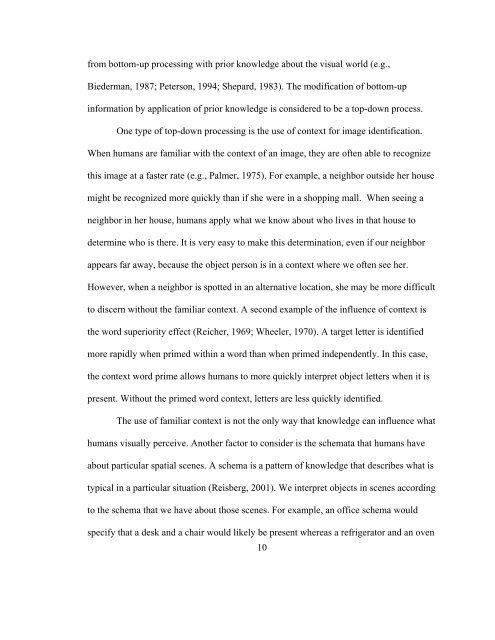The Use of Iambic Pentameter in the
The Use of Iambic Pentameter in the
The Use of Iambic Pentameter in the
You also want an ePaper? Increase the reach of your titles
YUMPU automatically turns print PDFs into web optimized ePapers that Google loves.
from bottom-up process<strong>in</strong>g with prior knowledge about <strong>the</strong> visual world (e.g.,<br />
Biederman, 1987; Peterson, 1994; Shepard, 1983). <strong>The</strong> modification <strong>of</strong> bottom-up<br />
<strong>in</strong>formation by application <strong>of</strong> prior knowledge is considered to be a top-down process.<br />
One type <strong>of</strong> top-down process<strong>in</strong>g is <strong>the</strong> use <strong>of</strong> context for image identification.<br />
When humans are familiar with <strong>the</strong> context <strong>of</strong> an image, <strong>the</strong>y are <strong>of</strong>ten able to recognize<br />
this image at a faster rate (e.g., Palmer, 1975). For example, a neighbor outside her house<br />
might be recognized more quickly than if she were <strong>in</strong> a shopp<strong>in</strong>g mall. When see<strong>in</strong>g a<br />
neighbor <strong>in</strong> her house, humans apply what we know about who lives <strong>in</strong> that house to<br />
determ<strong>in</strong>e who is <strong>the</strong>re. It is very easy to make this determ<strong>in</strong>ation, even if our neighbor<br />
appears far away, because <strong>the</strong> object person is <strong>in</strong> a context where we <strong>of</strong>ten see her.<br />
However, when a neighbor is spotted <strong>in</strong> an alternative location, she may be more difficult<br />
to discern without <strong>the</strong> familiar context. A second example <strong>of</strong> <strong>the</strong> <strong>in</strong>fluence <strong>of</strong> context is<br />
<strong>the</strong> word superiority effect (Reicher, 1969; Wheeler, 1970). A target letter is identified<br />
more rapidly when primed with<strong>in</strong> a word than when primed <strong>in</strong>dependently. In this case,<br />
<strong>the</strong> context word prime allows humans to more quickly <strong>in</strong>terpret object letters when it is<br />
present. Without <strong>the</strong> primed word context, letters are less quickly identified.<br />
<strong>The</strong> use <strong>of</strong> familiar context is not <strong>the</strong> only way that knowledge can <strong>in</strong>fluence what<br />
humans visually perceive. Ano<strong>the</strong>r factor to consider is <strong>the</strong> schemata that humans have<br />
about particular spatial scenes. A schema is a pattern <strong>of</strong> knowledge that describes what is<br />
typical <strong>in</strong> a particular situation (Reisberg, 2001). We <strong>in</strong>terpret objects <strong>in</strong> scenes accord<strong>in</strong>g<br />
to <strong>the</strong> schema that we have about those scenes. For example, an <strong>of</strong>fice schema would<br />
specify that a desk and a chair would likely be present whereas a refrigerator and an oven<br />
10

















